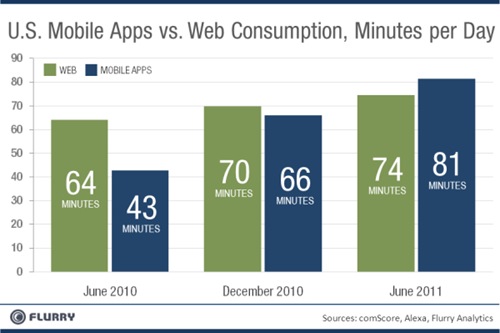Mobile operating systems are sprouting like mushrooms. There is one operating system coming up every year. Apple’s iOS, Google’s Android, RIM OS, Windows Phone 7, Symbian, Meego, Samsung Bada and Palm OS are some of the major mobile operating systems on last count. Each operating system has its own app store, developer ecosystem and ego boosting ‘x million apps downloaded in y days’ statistics. Without even getting in to Android’s fragmentation issues, I can tell you this : This is one holy mess for everyone involved. From this holy mess comes the debate of native apps vs web apps.
Aren’t native apps better than web apps?
I don’t think there is any debate here. Native apps are always better than web apps. Or in other words, there isn’t anything which a native app can’t do. But there are things web apps can’t do.
HTML 5 is seen as a dark knight to pull us all out but its adoption is not as it should have been. Every smartphone has a browser. How hard could that be? Very difficult actually. This graph from Flurry shows the grim reality of HTML 5 apps :
Graph source : GigaOM
The native app usage has gone up over the 12 months and web apps consumption hasn’t grown as it should. Anything can be inferred from this, but the biggest inference would be, web apps have to take a giant leap to compete with native apps. That’s where the predicament comes from for all the organizations who want to go mobile.
If you have unlimited resources to develop apps for iOS, Android, Windows, Bada and every new mobile operating system that comes out, then by all means go with native app. But no body has unlimited resources. New York Times would rather be spending its time on breaking the next big story rather worrying about Ice Cream Sandwiches and Mangoes.
Today if a publication, business or game developer has to reach out to users with smartphones, it’s nothing short of a herculean task. There are umpteen app stores to get on to and there are only so much resources. A publication like New York Times for example will have the wherewithal to develop apps for iOS, Android, Blackberry and Palm. A smaller publication or a business might not have resources at its disposal. They would rather settle with a single platform or two. iOS and Android are the two major platforms every one wants to be on. That’s like saying RIM users, we want to reach you but don’t have the money to make an app for you folks. And there are more iOS and Apple folks out there.
Web apps to the rescue. But…
Web apps, or websites optimized for mobile access is an obvious solution which is both cost-effective and has the potential to reach bigger audience. The only problem with web apps is they came as an after thought. By the time people started thinking about web apps, Apple’s app store is in full swing with thousands of apps and Android has added fire to the fuel. Between all top mobile OS’s there are close to 800,000 native apps.
There are few souls who dared to go against the app store mess. Financial Times has launched its mobile friendly website aka web app which needs little tweaking to suit to all the platforms. There are iOS app or an Android app. All it takes is a single website : m.ft.com. Once the user enters the site, the app will detect the OS and change its alignment accordingly. It is basically a single app with multiple configuration files. If there is a new OS, then there would be a new configuration file and not necessarily a new app. I might have oversimplified the process but that’s the gist.
Should we go with a web app then? I wish the answer was simple. It’s not. It depends on what you want to achieve with your app. For Financial Times, it needs the internet connection for some time and the app can cache the pages. It doesn’t necessarily need to know your location. If FT were trying to push a local news then its web app would fall short. Web apps are limited in the way they function. They still cannot access features on your phone. Foursquare for example which relies heavily on your location to check you in, cannot do away with a web app. It needs to interact with the GPS on the phone and know the location which is something far fetched in a web app but not without hope. There’s is progress already.
Compelling web apps can be developed. Google has developed web apps for all its services which is what I use on my iPhone. If iOS users have to access Google Plus, they have to do so through a web app. There’s no native app available for iOS yet, though there’s one for Android. Angry Birds release for Chrome browser which lets you play without Internet access is yet another example for the potential of a web app. Though the Chrome app will run on desktop browsers, the concept can be extended to smartphone browsers as well.
HTML 5 is making things a lot easier for app developers but the user experience is not as good as an experience with a native app. Not yet.
If the current challenge for native apps is fragmentation, the challenges for web apps are discovery and feature set to compete with native apps.
Finally…
Google releases an upgrade every six months, Apple every eight months and Windows would probably release it every month. There is no way any organization could keep up with that kind of pace. At some point, everybody will be tired with updating their mobile apps and their umpteen upgrades. When people get tired that’s when real innovation will go in to the web app space. It’s only a matter of when and not if. Web apps and HTML 5, are the only way anyone can tame this smartphone stallion.
If native apps are the present, web apps are the future.







![Top 8 Best 6 GB RAM Mobile Phones [2017]](https://thegadgetfan.com/wp-content/uploads/2016/03/Vernee-Apollo.jpg)

![Top 15 Mobiles With Longest Battery Life [12 hours +]](https://thegadgetfan.com/wp-content/uploads/2014/10/increase-battery-backup-tgf.png)